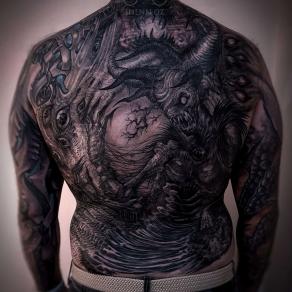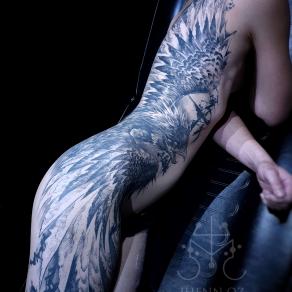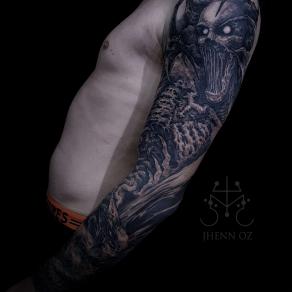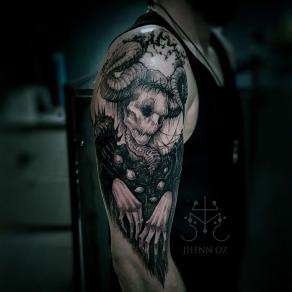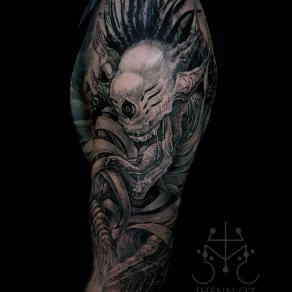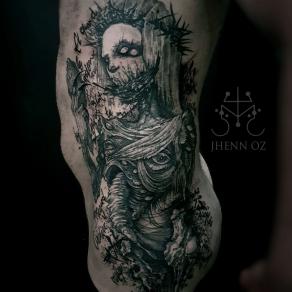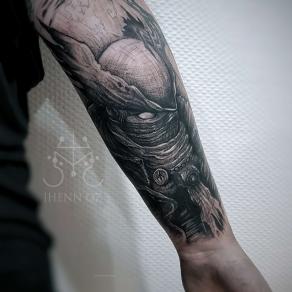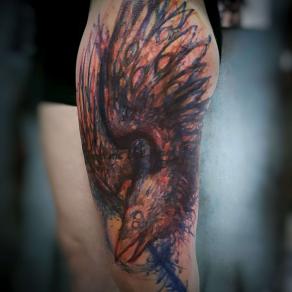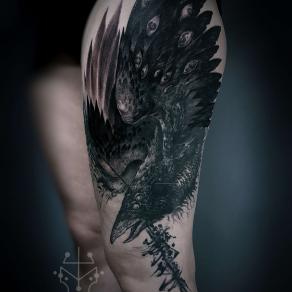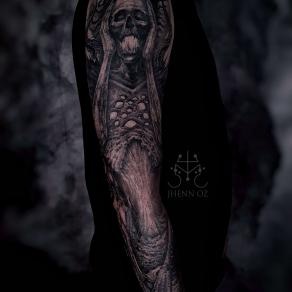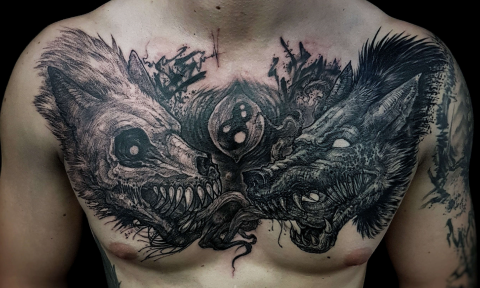
What exactly is a dark tattoo, and how does it differ from blackwork and blackout tattoos? Which are the most popular dark tattoo designs, and which tattoo artists have made this style famous? A guide from La Bête Humaine!
Dark tattoo, blackwork, blackout: What are we talking about?
Dark, blackwork, blackout: these different tattoo schools may have commonalities, yet they represent three distinct areas. Let's define!
The dark tattoo: dark ideas
In English, the adjective "dark" refers to the absence of light, the color black, or the night. However, in the tattoo world, it's more about the essence than the shape. Indeed, a dark tattoo is a design or composition that focuses on a motif considered dark, shadowy... or even downright macabre.
This identity has inspired several translation attempts in French, such as:
- obscure tattoo
- funeral tattoo
- gloomy tattoo
- occult tattoo
- and more
Blackwork tattoo: 50 shades of black
Unlike the dark tattoo, characterized by motifs with very dark symbolisms, the blackwork tattoo is recognizable by its form. As the name suggests, it's defined by the almost exclusive use of the color black, with almost no gray shading. Blackwork tattoos complement certain graphic or ornamental designs particularly well.
Blackout tattoo: in complete darkness
A blackout tattoo stands apart from both the dark tattoo and the blackwork tattoo. It denotes a more or less broad skin area tattooed entirely in black. In other words, it represents a solid black ink patch which can:
- cover a previous tattoo
- serve as a base for white ink designs
- or simply stand on its own!
Dark tattoo ideas
Monstrous creatures, decomposing corpses, incubi, and succubae: dark tattoos encompass all these... and more. Here's an overview.
Essential designs of the dark tattoo
As mentioned earlier, dark tattoos often depict forms commonly associated with horror, terror, and other grim concepts. Hence, dark tattoo artists might be drawn to themes like:
- death with the ever-popular skull, skeletons, exposed organs...
- religion with imagery of hell, the devil, demons...
- fantasy populated by bloodthirsty monsters, evil sorcerers, and disturbing ghouls...
- unfriendly animals such as snakes, spiders, and scorpions...
This list is far from exhaustive.
A reinterpretation of pop culture with a dark twist
But dark tattoos also transcend these traditional boundaries. Even better: they excel at reinterpreting pop culture in a gothic style! Japanese culture (mangas leading the way), Greco-Roman or Norse mythology, video games, and even Disney tales: everything can be reimagined through blackwork to become a dark tattoo...
Tattoo artists specializing in dark and blackwork tattoos
They have made the dark and blackwork styles their favorite canvas on the skin. La Bête Humaine introduces you to some of the must-know artists in this field. A touch of subjectivity included!
Masters of dark tattooing
Paul Booth is one of the guiding lights of the dark movement. His black and gray works paved the way for an entire generation of tattoo artists; in the 1990s, he was one of the few artists delving into skulls, demons, odd embryonic creatures, and horned things, all while fully respecting the client's body shape. Finally, a tattoo artist who followed body lines instead of just stamping designs onto the skin! Among his successors in the magnificent dark, we have:
Experts in blackwork tattooing
If there's one name to remember in blackwork, it's undoubtedly Jean-Luc Navette. His unique approach made his work profoundly complete, despite a complete absence of gray shades. Blackworkers are like his disciples, having absorbed the essence of Navette's style: very dark, textured, twisted designs, and characters with unsettling proportions... Both chilling and sublime. Among his worthy successors, we find:
Frequently asked questions about dark tattoos
Aging, required care, touch-ups: our FAQ based on the most common queries on search engines!
How does a black tattoo age?
A black tattoo ages like a colored one: the quality of its aging depends on the care you provide. The more you expose it to the sun, the more your tattoo will fade; ultraviolet (UV) rays alter the pigments. Regularly moisturize your tattoo with a cream specifically for tattoo care.
Why does a black tattoo turn blue?
Black tattoo ink is not pure black: it's a mix of colors, sometimes including blue. This composition explains why, over time, a once-black tattoo might develop a bluish tint. The triple remedy: protect from the sun, moisturize regularly, and choose an experienced tattoo artist using the best inks!
How to keep a tattoo very black?
First step: minimize sun exposure, especially just after getting tattooed! Allow at least three weeks to a month between getting your tattoo and sun exposure. This period allows your tattoo to heal, making it more resistant to tattoo's worst enemy: UV rays. Also, moisturize your skin regularly.
How to fix a black tattoo?
A botched blackwork tattoo isn't the end of the world. You can ask a tattoo artist for a cover-up; in this case, anticipate the new design to be at least twice the size of the original. Also, laser removal can diminish some tattoo areas to make room for a more successful design.
Is it possible to tattoo over blackwork with white ink?
Yes, but beware! White ink isn't as opaque as black and won't "cover" a black tattoo. Rather, it will create a lighter gray shade. However, it can be an option if you're looking for a faded effect or to add small highlights.
Jhenn Oz, Dark Tattoo Artist at La Bête Humaine
At La Bête Humaine, our dark tattoo specialist is a tattoo artist: Jhenn Oz, a macabre artist and a regular guest at our Parisian tattoo studio. Let's take a closer look at her approach and provide practical information for offering your skin under her tattoo machine.
Jhenn's Process, from Initial Contact to Tattooing
First step: send us an email at guest.lbh@gmail.com to discuss your project! Let Jhenn know:
- the theme you want for your tattoo
- the elements you wish to include
- the symbols that are meaningful to you
- where you want your tattoo
- the intended size of your piece
Jhenn doesn’t offer any pre-made designs but practices exclusively freehand tattooing. This means a tattoo done without a stencil, in other words, without the artist having first printed your design on carbon paper before applying it to your skin. With freehand tattooing, the artist draws your tattoo directly onto your skin with a marker, and once you've given your approval, she starts tattooing.
Through email or over the phone, the project is a collaborative effort: you on one side, and Jhenn on the other. On the day of, Jhenn will show you the design she's worked on and apply it in marker to your skin. The conversation continues throughout this stage: you're free to add, remove, reshape, or redesign every element.
Once the design is approved, Jhenn finalizes the outline and the tattooing begins! She starts by inking the darkest colors, then the medium shades, and finally finishes with the whites and any necessary touch-ups.
On average, expect roughly:
- 7 sessions for a full arm
- 11 sessions for a full back
Getting Tattooed by Jhenn Oz During Her Next Guest Appearance in Paris
Want to experience her craft? Click on her profile to see her next visit dates at 5 rue Pierre Chausson (10th arrondissement of Paris). To submit your project and book your Parisian session with her, you have four options:
- send us an email at guest.lbh@gmail.com
- message us privately on our Facebook page
- DM us on our Instagram account
- call us at +33144596820
All visuals used in this article are from Jhenn Oz's portfolio: a big thank you to her!

